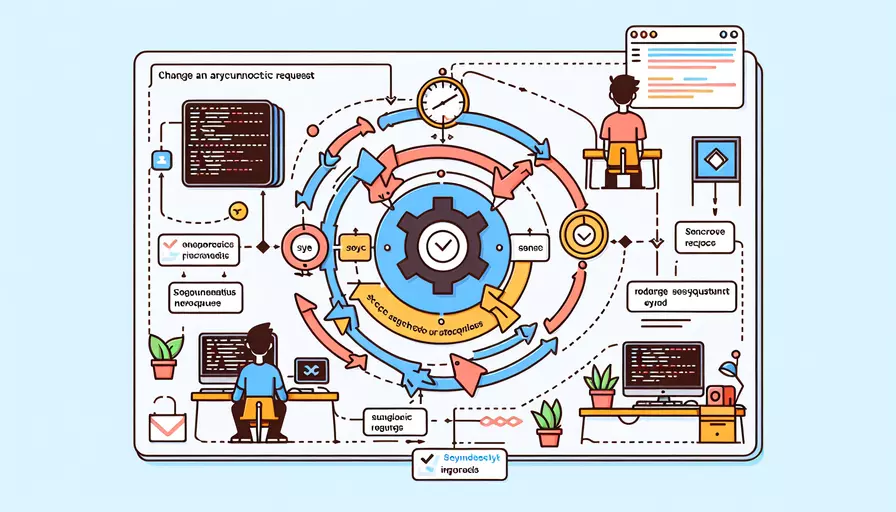
Vue 异步请求可以通过以下步骤改为同步:1、使用 async 和 await 语法;2、使用 Promise 的 then 和 catch 方法;3、利用事件监听和回调函数。 下面将详细描述如何通过这些方法实现同步效果。
一、使用 async 和 await 语法
在 Vue.js 中,使用 async 和 await 是最常见的将异步请求改为同步执行的方法。通过这种方式,你可以使代码看起来像是同步执行的,尽管它实际上仍然是异步的。
- 定义一个异步方法:你可以在 Vue 组件中定义一个异步方法,并使用 async 关键字。
- 使用 await 等待请求完成:在异步方法中使用 await 关键字等待异步请求完成。
示例代码:
export default {
data() {
return {
result: null
};
},
methods: {
async fetchData() {
try {
const response = await axios.get('https://api.example.com/data');
this.result = response.data;
} catch (error) {
console.error('Error fetching data:', error);
}
}
},
created() {
this.fetchData();
}
};
二、使用 Promise 的 then 和 catch 方法
另一种方法是使用 Promise 的 then 和 catch 方法,将一系列异步操作串联起来,确保它们按顺序执行。
- 发起异步请求:使用 axios 或 fetch 发起一个异步请求。
- 使用 then 方法:在 then 方法中处理请求结果,并发起下一个请求。
- 使用 catch 方法:在 catch 方法中处理任何可能的错误。
示例代码:
export default {
data() {
return {
result: null
};
},
methods: {
fetchData() {
axios.get('https://api.example.com/data')
.then(response => {
this.result = response.data;
return axios.get('https://api.example.com/another-data');
})
.then(response => {
console.log('Another request result:', response.data);
})
.catch(error => {
console.error('Error fetching data:', error);
});
}
},
created() {
this.fetchData();
}
};
三、利用事件监听和回调函数
另一种使异步请求看起来像同步执行的方法是使用事件监听和回调函数。这种方法适用于需要在某个事件触发后执行一系列异步操作的情况。
- 发起异步请求:在特定事件触发时发起异步请求。
- 使用回调函数:在回调函数中处理请求结果,并发起下一个请求。
示例代码:
export default {
data() {
return {
result: null
};
},
methods: {
fetchData(callback) {
axios.get('https://api.example.com/data')
.then(response => {
this.result = response.data;
if (callback) callback();
})
.catch(error => {
console.error('Error fetching data:', error);
});
},
fetchAnotherData() {
axios.get('https://api.example.com/another-data')
.then(response => {
console.log('Another request result:', response.data);
})
.catch(error => {
console.error('Error fetching data:', error);
});
}
},
created() {
this.fetchData(this.fetchAnotherData);
}
};
四、原因分析和背景信息
在 JavaScript 中,异步请求是通过 Promise、回调函数或 async/await 机制来实现的。由于 JavaScript 的单线程特性,异步编程确保了不会阻塞主线程,从而提升了应用的性能和用户体验。然而,在某些情况下,我们可能需要保证一系列异步操作按顺序执行,这时候可以通过上述方法实现同步效果。
- async/await:这是 ES2017 引入的语法糖,使异步代码看起来更像是同步代码,便于阅读和维护。它实际上是基于 Promise 的。
- Promise then/catch:这是 ES6 引入的异步编程解决方案,通过链式调用 then 和 catch 方法,可以处理一系列异步操作。
- 事件监听和回调函数:这种方法适用于复杂的异步操作链,尤其是在需要处理多个不相关的异步请求时。
五、实例说明
以下是一个更为复杂的实例,展示了如何在实际应用中使用上述方法:
export default {
data() {
return {
userData: null,
posts: null
};
},
methods: {
async getUserData() {
try {
const userResponse = await axios.get('https://api.example.com/user');
this.userData = userResponse.data;
const postsResponse = await axios.get(`https://api.example.com/user/${this.userData.id}/posts`);
this.posts = postsResponse.data;
} catch (error) {
console.error('Error fetching data:', error);
}
},
fetchDataWithPromise() {
axios.get('https://api.example.com/user')
.then(userResponse => {
this.userData = userResponse.data;
return axios.get(`https://api.example.com/user/${this.userData.id}/posts`);
})
.then(postsResponse => {
this.posts = postsResponse.data;
})
.catch(error => {
console.error('Error fetching data:', error);
});
},
fetchDataWithCallback() {
this.getUserDataCallback((userData) => {
axios.get(`https://api.example.com/user/${userData.id}/posts`)
.then(postsResponse => {
this.posts = postsResponse.data;
})
.catch(error => {
console.error('Error fetching data:', error);
});
});
},
getUserDataCallback(callback) {
axios.get('https://api.example.com/user')
.then(userResponse => {
this.userData = userResponse.data;
if (callback) callback(this.userData);
})
.catch(error => {
console.error('Error fetching data:', error);
});
}
},
created() {
this.getUserData(); // 使用 async/await
// this.fetchDataWithPromise(); // 使用 Promise then/catch
// this.fetchDataWithCallback(); // 使用事件监听和回调函数
}
};
总结
综上所述,Vue 异步请求可以通过使用 async 和 await 语法、Promise 的 then 和 catch 方法以及事件监听和回调函数来改为同步效果。虽然这些方法并不能真正将异步请求变为同步,但可以使代码看起来像是同步执行的,从而提高代码的可读性和可维护性。建议根据具体场景选择合适的方法,并始终注意错误处理,确保应用的稳定性和可靠性。
相关问答FAQs:
1. Vue中的异步请求和同步请求有什么区别?
异步请求和同步请求是在Vue中处理数据时的两种不同的方式。异步请求是指在发送请求后,不会等待服务器返回结果,而是继续执行后续的代码。而同步请求是指发送请求后,会一直等待服务器返回结果,然后再继续执行后续的代码。在大多数情况下,我们通常使用异步请求来避免页面卡顿或阻塞。
2. 如何在Vue中将异步请求改为同步请求?
在Vue中,由于浏览器的安全策略限制,无法直接将异步请求改为同步请求。因为同步请求会导致浏览器界面被阻塞,用户体验较差。然而,我们可以通过一些技巧来实现类似于同步请求的效果。
3. 如何使用Promise和async/await来实现类似于同步请求的效果?
在Vue中,我们可以使用Promise和async/await来实现类似于同步请求的效果。我们可以将异步请求封装在一个Promise对象中,并使用async/await来等待Promise对象的结果。
// 使用Promise和async/await将异步请求改为类似于同步请求的写法
async function fetchData() {
try {
const response = await axios.get('https://api.example.com/data');
const data = response.data;
return data;
} catch (error) {
console.error(error);
throw error;
}
}
// 在Vue组件中使用async/await来获取数据
export default {
data() {
return {
fetchDataResult: null,
};
},
async mounted() {
try {
this.fetchDataResult = await fetchData();
// 在这里可以继续执行后续的代码,处理获取到的数据
} catch (error) {
// 处理错误情况
}
},
};
通过以上的代码示例,我们可以看到在Vue组件中使用async/await结合异步请求的方式,可以实现类似于同步请求的效果。但是需要注意的是,这种方式仍然是异步请求,只是通过语法糖的形式让代码看起来更像是同步执行的。
文章标题:vue 异步请求如何改为同步,发布者:飞飞,转载请注明出处:https://worktile.com/kb/p/3656287

 微信扫一扫
微信扫一扫  支付宝扫一扫
支付宝扫一扫 